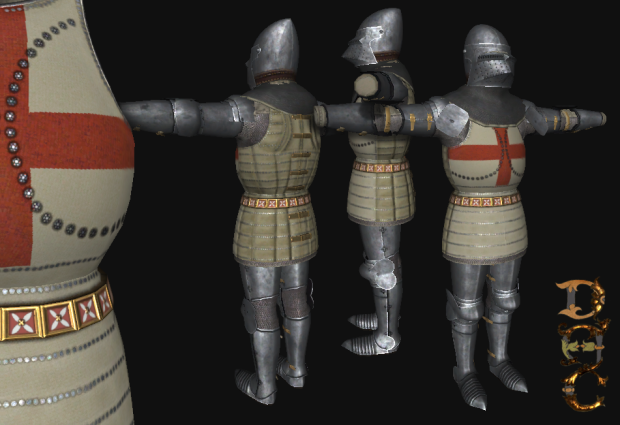Deeds of Arms and Chivalry is a modification for Mount & Blade: Warband which focuses on the Hundred Years War between France and England, specifically during the early 15th Century.
English knight, 1400. A houndskull visor on a peaked basinet with a mail aventail atop an advanced coat-of-plates. His arm and leg harnesses are English-pattern.
Such a panoply would appear strange on the battlefield to a continental European knight, since he would not require plate defenses on the inside of his thighs, or high-mobility shoulder defenses that would allow him to lift his arms fully above his head.
But then again, he would not expect to join battle on foot, let alone fight mounted enemy cavalry on foot, far less hold a line on foot against a heavy cavalry charge. That sort of thing is foot-soldier's work, and knights typically aspired to mounted chivalric combat. Typically, mind you.
Made by AsherNitin, Noooxy and Wespenwald.
Note: The only detail we've opted to exclude are the golden spurs.








This is lovely, thank you for sharing this with us!! You are all indeed very talented.
I wonder if there were some "convergent development" with the English and Italian armor styles.
Italy provided both manpower and materiel for the duration of the HYW. Zeneiese X-bowmen, mounted condottiere. These two troop types would make their reputation in the HYW. So when we consider crossover Eng-Italian designs, we must not think only knightly armor.
The best piece that comes to mind is the sallet with the hinged cheekplate, intended for archers. The sallet itself is rather deep/tall, more like a barbuta, and the English did like it, with one lord ordering hundreds for his retinue archers.
But that is the only one I can think of. Truth is, the Italian and English knights had very unique styles in 1430. Over time, by 1450, the English would adopt the German Gothic style, so Italy would evolve to remain their main supplier by making sets in the German style.
So, in 1430, there are two major design styles; Italian and German, aka Milanese and Gothic, and one minor design style: English. The Italians excel at manufacture, trade and innovation. The Germans excel at more unorthodox forms of innovation.
By 1450, the English style is very reduced, with many preferring to adopt the German Gothic style, which is technically superior to other styles (fluting, weight, etc). The Italians continue to use their native style for their own people, but for export purposes, they make German-style armor.
Question, I usually see leg armours in re-enactors and manuscripts depicted with just plain hosen underneath. Was it historical to have mail underneath the leg armour to protect the back of the knees?